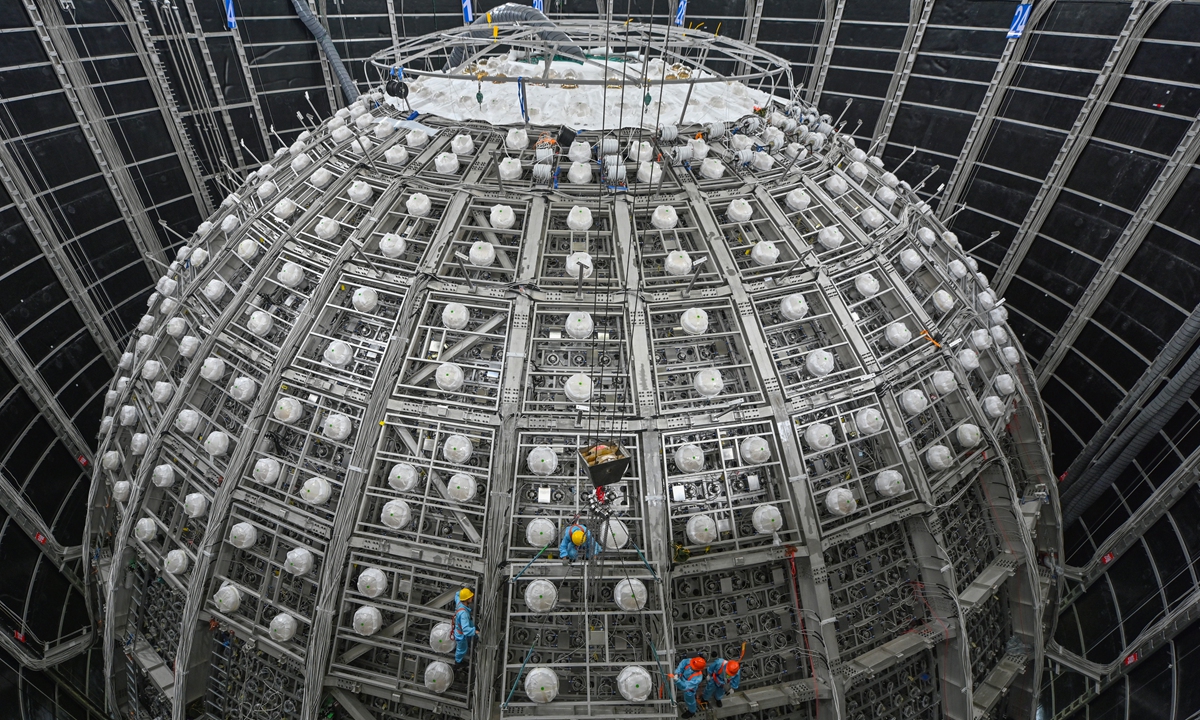
Working staff install equipment into the JUNO veto detector system which is designed for cosmic muon detection and background reduction. Photo: Courtesy of IHEP
The construction of the core component of the Jiangmen Underground Neutrino Observatory (JUNO) was completed on Wednesday. The major scientific facility, situated 700 meters underground in Jiangmen, South China's Guangdong Province, is entering its final construction phase, according to the Institute of High Energy Physics (IHEP) of the Chinese Academy of Sciences (CAS).
Jointly launched by the CAS and the Guangdong provincial government in 2015, JUNO has been designed to detect neutrinos, which are among the oldest and most fundamental particles in the universe. They could hold the key to explaining why matter dominates the universe instead of antimatter or to unifying the theories of how the four fundamental forces of the universe - gravitational, electromagnetic, strong nuclear and weak nuclear - work.
Neutrinos are often referred to as "ghost" particles because they have almost no mass and rarely interact with other matter, making them extremely difficult to detect.
He Miao, the leader of the neutrino group at the Experimental Physics Center of IHEP, told the Global Times that since Austrian scientist Wolfgang Pauli proposed the neutrino hypothesis in 1930, research on neutrinos has spanned nearly a century. In the 1970s, the experimental discovery of weak neutral currents marked a milestone in the history of particle physics. Around 2000, scientists in Japan and Canada independently observed the oscillation phenomenon of atmospheric and solar neutrinos respectively, a breakthrough that led to scientists from both countries being awarded the Nobel Prize in 2015.
Following the discovery of the atmospheric and solar neutrinos oscillation phenomenon in Japan and Canada, China's Daya Bay Reactor Neutrino Experiment uncovered a new mode of neutrino oscillation for the first time in 2012. This discovery not only completed the theoretical framework of neutrino oscillation, but also provided guidance for next-generation experiments in determining the mass ordering of neutrinos. Against this backdrop, the JUNO project was initiated, with its primary physical goal being to determine the mass ordering of neutrinos by detecting the energy spectrum of neutrinos produced from the nuclear fission processes of reactor cores.
When asked why JUNO needed to be built 700 meters underground, he explained that a neutrino detector has the highest sensitivity when located about 50 kilometers from nuclear reactors. However, cosmic rays can also be detected by the detector, which interferes with neutrino detection. Rocks can effectively shield against cosmic rays, which is why the detector needs to be built underground. The 700-meter mountain can reduce the event rate of cosmic rays by nearly 100,000 times.
Dashishan in Jiangmen's Jinji township is 53 kilometers away from the high-power nuclear reactors in Taishan and Yangjiang. The mountain provides effective shielding against cosmic rays, creating an ideal environment for the experiment, according to He.
The main structure of JUNO resembles a watermelon submerged in water, with the entire sphere forming the world's most precise and largest liquid scintillator detector. The core detection equipment is situated in the center of a 44-meter-deep water pool in the underground laboratory. It consists of a 41-meter-diameter stainless steel mesh shell, a 35.4-meter-diameter acrylic sphere, 20,000 tons of liquid scintillator, and 45,000 photomultiplier tubes, among other key components, according to IHEP.
According to experts, the liquid scintillator serves as the medium for detecting neutrinos. When a large number of neutrinos pass through the detector, they interact with the scintillator, emitting extremely weak scintillation light, which is then detected by the photomultiplier tubes. These 45,000 photomultiplier tubes act as "eyes," densely arranged on the inner side of the stainless steel mesh, facing the acrylic sphere and constantly monitoring the light signals emitted from within it. They convert the light signals emitted when neutrinos are captured into electrical signals and amplify them by 10 million times, thereby obtaining information about their energy and position for computer analysis.
To accurately measure the mass of neutrinos, the current approach involves observing the neutrino oscillation to determine their relative masses. Describing neutrino oscillation requires six parameters. Of these, four have already been successfully measured by scientists, including one detected by Chinese researchers of the Daya Bay experiment. The remaining one and a half parameters are the focus of the JUNO project, according to Wang Yifang, a CAS academician and director of IHEP.
In the future, Chinese scientists aim not only to determine the absolute mass of neutrinos, but also to uncover the relative mass differences between them through the study of neutrino oscillations. By investigating these mass properties, they hope to develop a theoretical framework that enhances people's understanding of the physical world, and sheds light on the origins and evolution of the universe. This research will ultimately contribute to humanity's quest to better comprehend both the cosmos and the fundamental nature of matter, according to Wang.
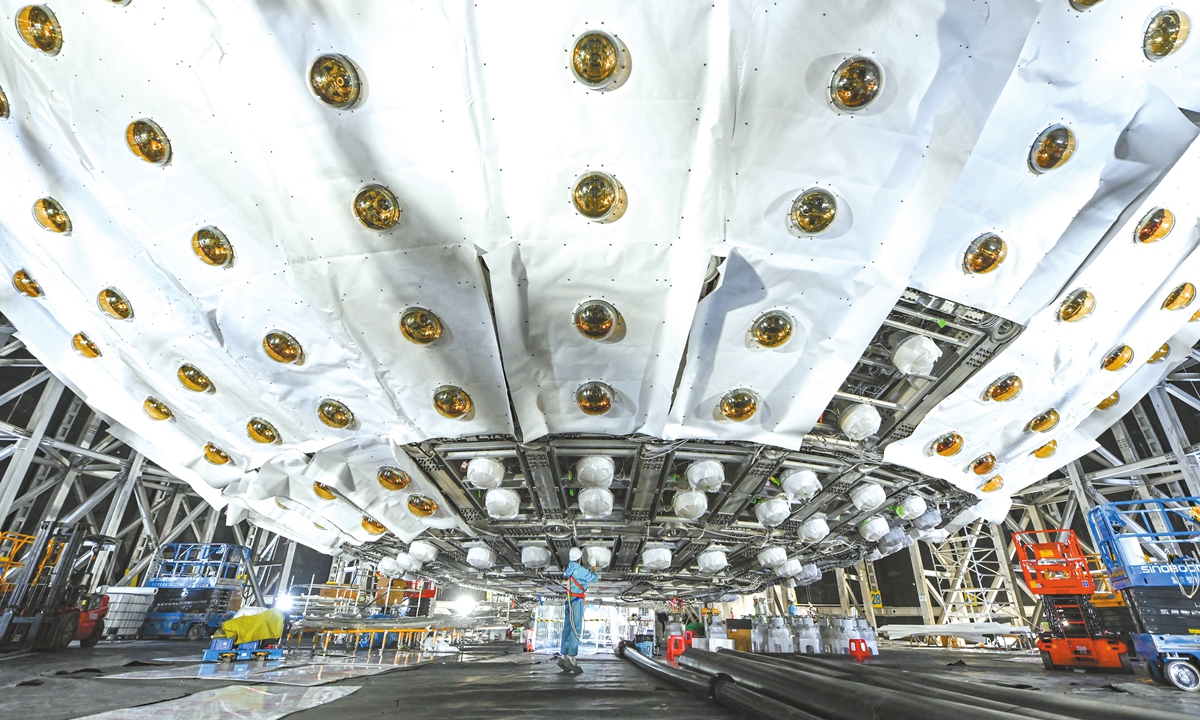
Bottom view of JUNO neutrino detector Photo: Courtesy of IHEP
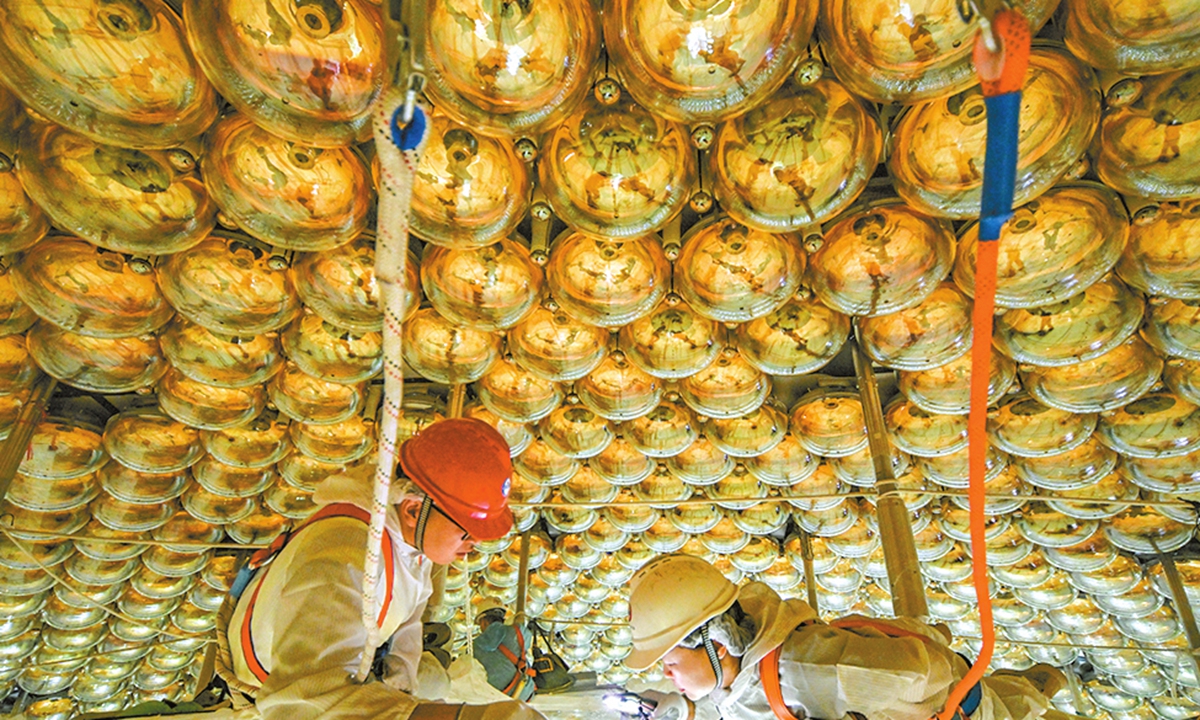
Working staff check the installation of JUNO's acrylic spheres. Photo: Courtesy of IHEP
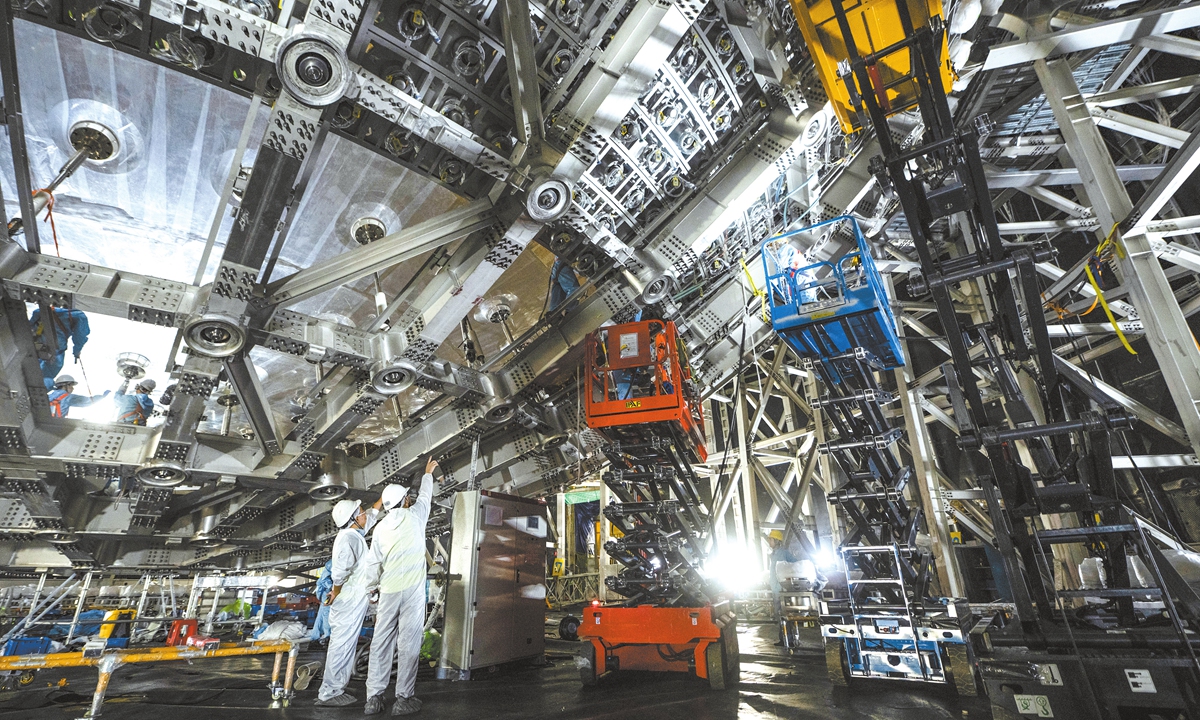
Working staff install equipment into the JUNO veto detector system which is designed for cosmic muon detection and background reduction. Photo: Courtesy of IHEP
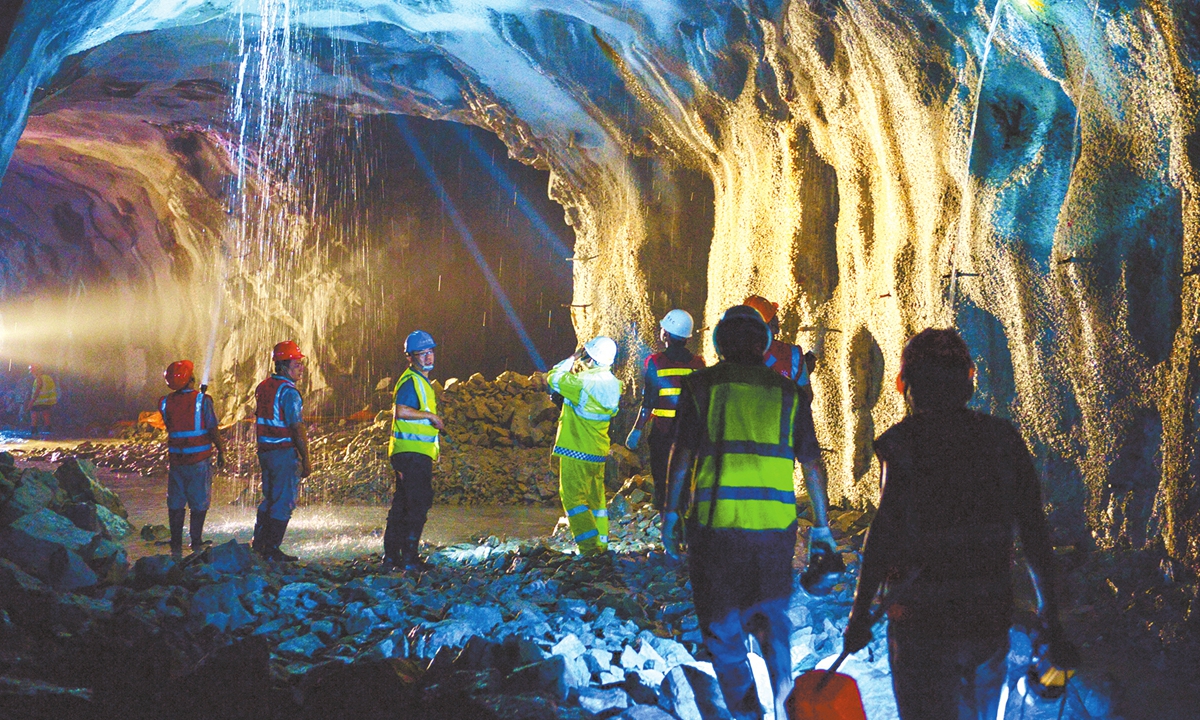
Working staff check the supporting infrastructure construction of JUNO. Photo: Courtesy of IHEP
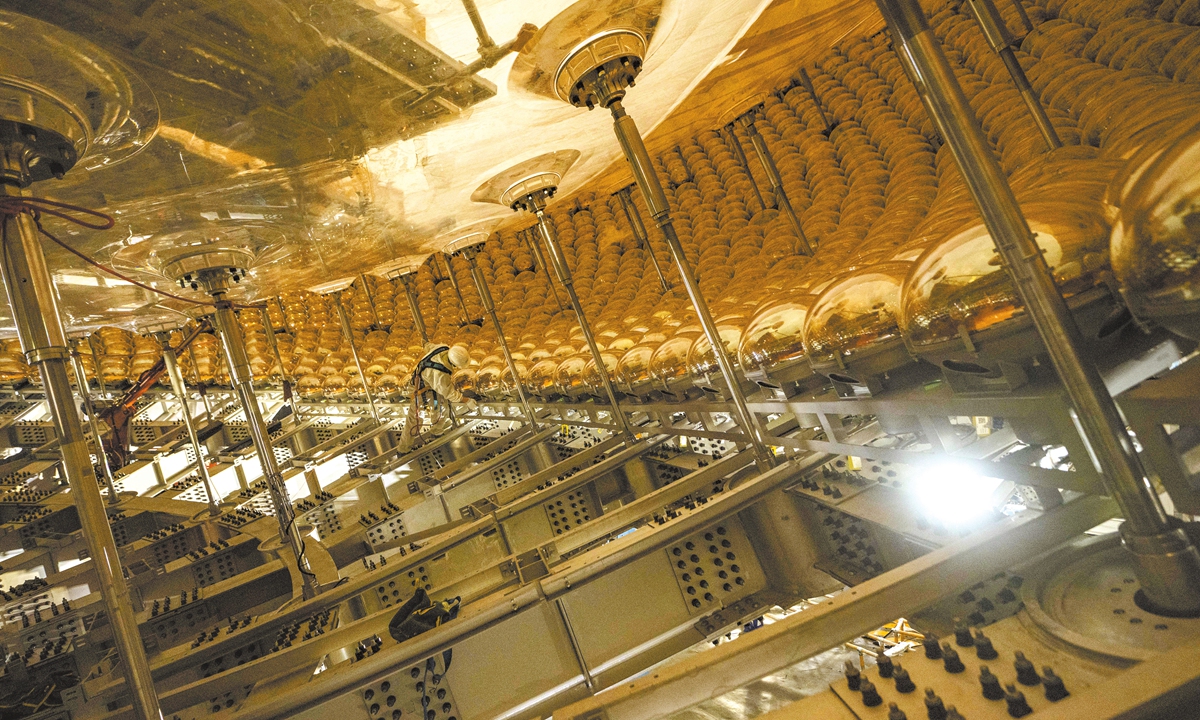
The installed photomultiplier tubes near the bottom of JUNO's stainless steel truss Photo: Courtesy of IHEP
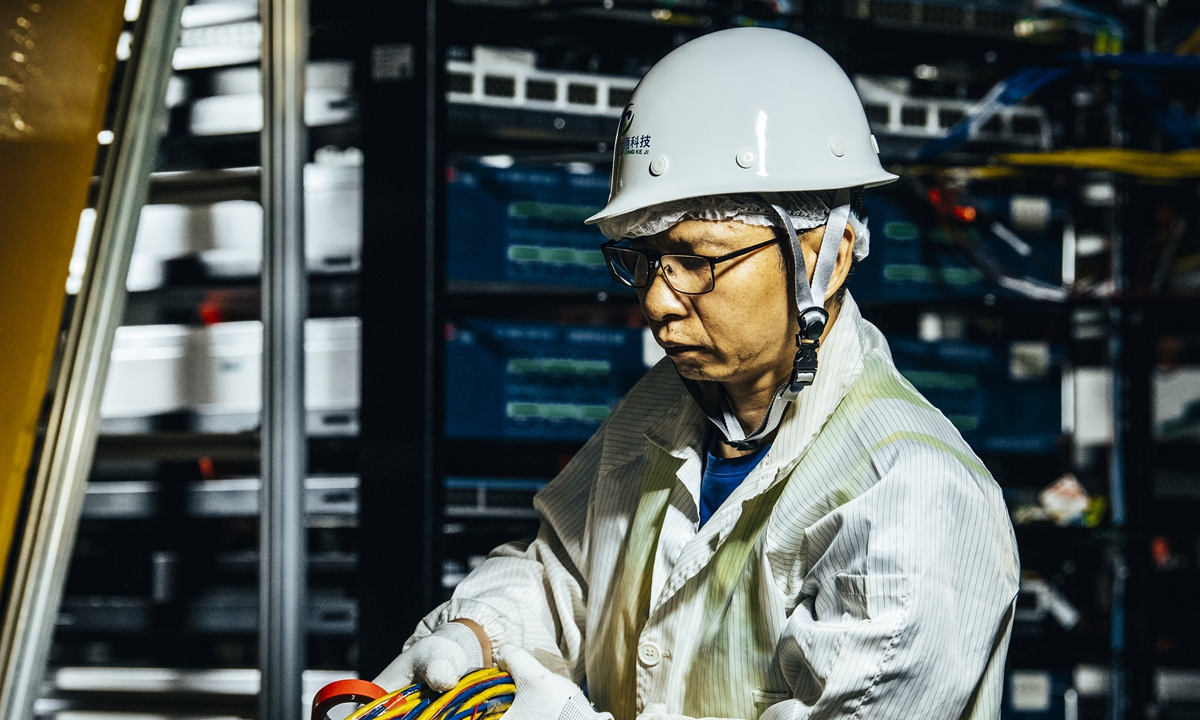
A technician works at the JUNO construction site. Photo: VCG










